|
| |
FAMILY PROTONEURIDAE
- This page contains information and pictures about Orange Threadtail
Damselflies that we found in the Brisbane area, Queensland, Australia. They are
also known as Ochre Threadtail
Damselflies.
-
 - Body length 35mm
- The above pictures was taken near a pond in Eight Mile Plains in Brisbane during
mid summer, where quite a number of different damselflies and dragonflies
can be found.
-
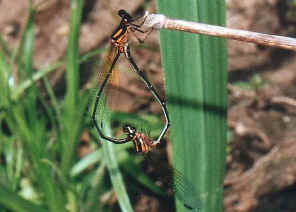
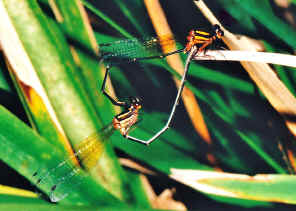
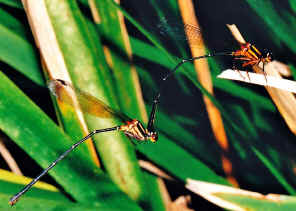 -
- Orange Threadtails are common in Brisbane waters.
They can be found near semi-shaded running water. They usually rest in group on
the plants at water edges in shady area. They can be seen even in winter time. The pictures in this
web page are mostly taken at Wishart and Eight Mile Plains along Bulimba Creek.
-
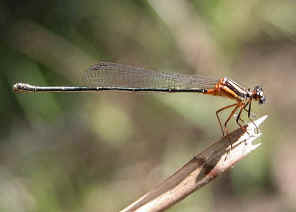 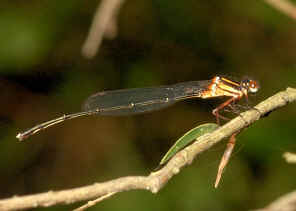
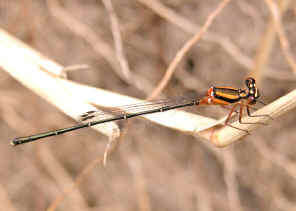 -
- When Ochre Threadtail
Damselflies are at rest, they held their wings closely folded
up vertically over their thorax. Their flying skill is very good,
although not in high speed. They
can fly backwards and sideways. They hover most of the time.
-
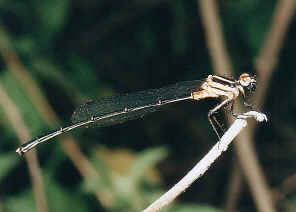 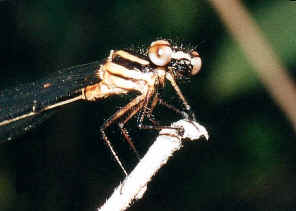
- Male
-
- The male Orange Threadtail damselflies have the orange- yellow thorax with black patterns.
The abdomen is narrow, black in colour with yellow strips. There is the
brown yellow colour at the base of their wings.
-
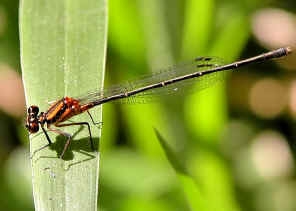 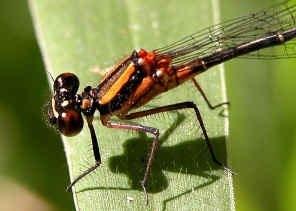 - Female
- Females are same in size with pale brown in
colour. They have the same black patterns.
-
Tandem and Wheel
- Their mating behavior is quite different from other insects, but more
or less the same for all dragonflies and damselflies. The
male damselflies and dragonflies have two sets of genitalia. One at the
abdomen tip as all the other insects. The other is known as secondary
genitalia, at the underside of the second abdomen segment. Before mating,
the male will transfers his sperm from his tip to the secondary genitalia.
-
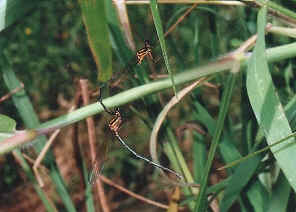
 - Male and female Ochre Threadtail Damselflies in tandem and wheel position.
-
- The male usually defines his own territory, protects it by driving away
the same species male. When a female come into his territory, the male
will grasp her 'neck' with his anal appendages to form the tandem
position. They may fly together in tandem position for
sometime.
- Eventually they will land on a plant or some other suitable location. The
female then will bend her abdomen tip to reach the male's secondary
genitalia to form the wheel position. In the male's secondary genitalia,
there is his sperm in which he had transferred from his abdomen apex on
earlier time. Then the sperm transfer takes place. The wheel position will
usually take 5 to 15 minutes.
-
- Then the female will return to the water and lay her eggs, usually with the
male still in tandem position.
-
- Damselflies lay their eggs in the plants under the surface of water.
Female damselflies have their blade-like ovipositor for making an opening in
the plant for her eggs. She lay her eggs alone or sometime still in tandem
with the male. More about their mating behavior can be find on this
page.
-
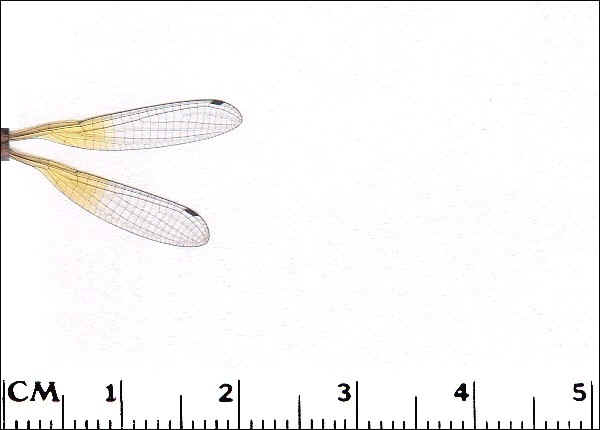 - Wings of Ochre Threadtail Damselfly
- Reference:
- 1. The Australian Dragonflies - CSIRO, Watson, Theisinger &
Abbey,1991, p146.
- 2. A
Field Guide to Dragonflies of South East Queensland - Ric Nattrass,
2006, p27.
- 3. The
Complete Field Guide to Dragonflies of Australia - CSIRO, GŁnther
Theischinger and John Hawking, 2006, p60.
Back to Top
[ Up ]
| |
|













